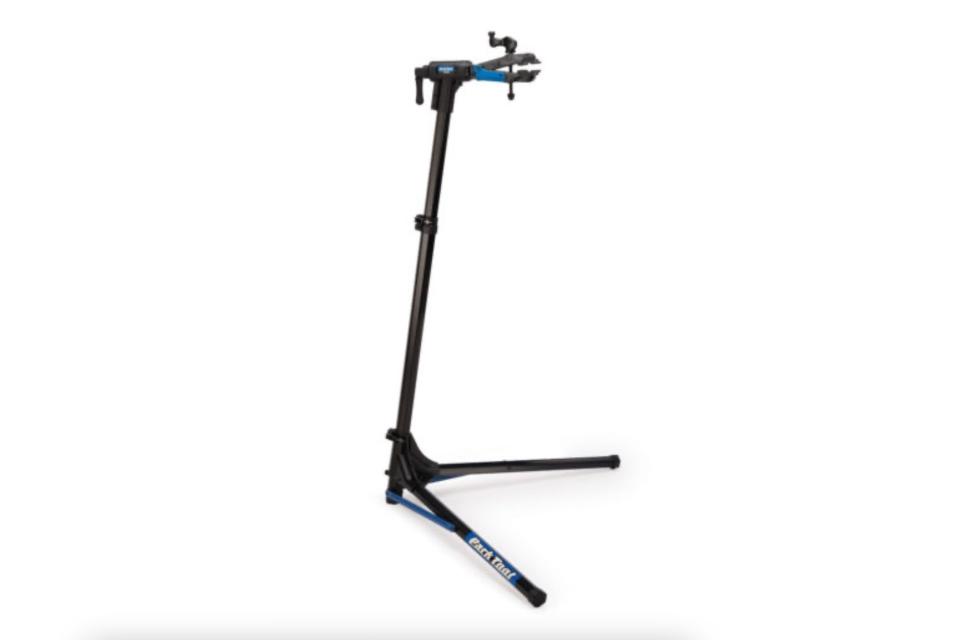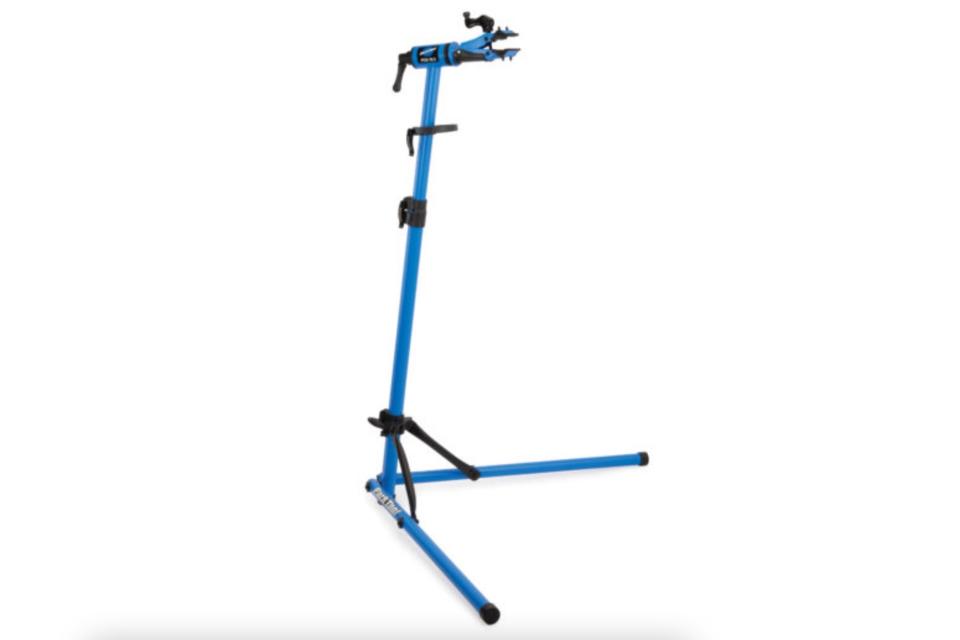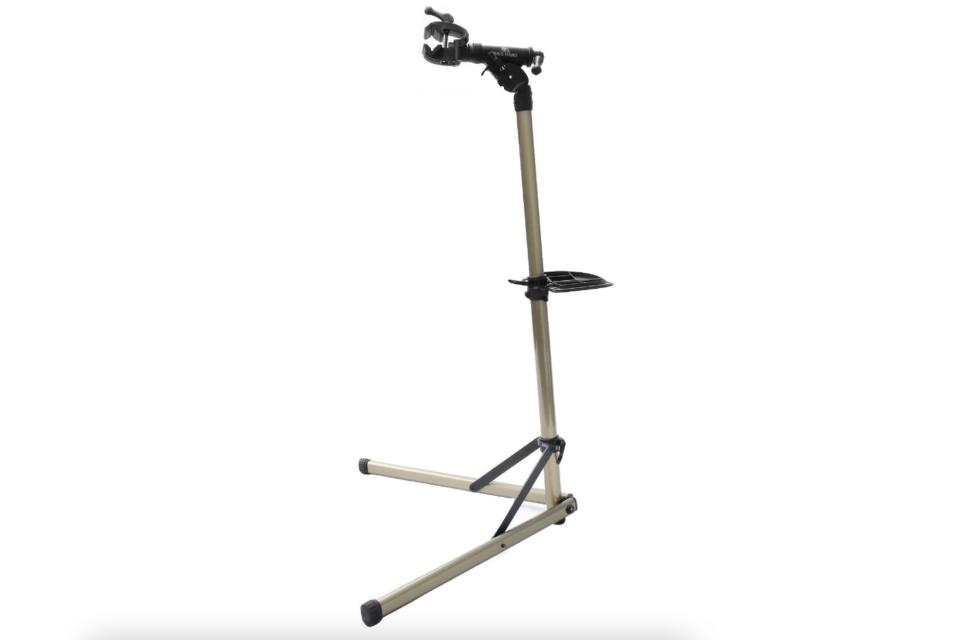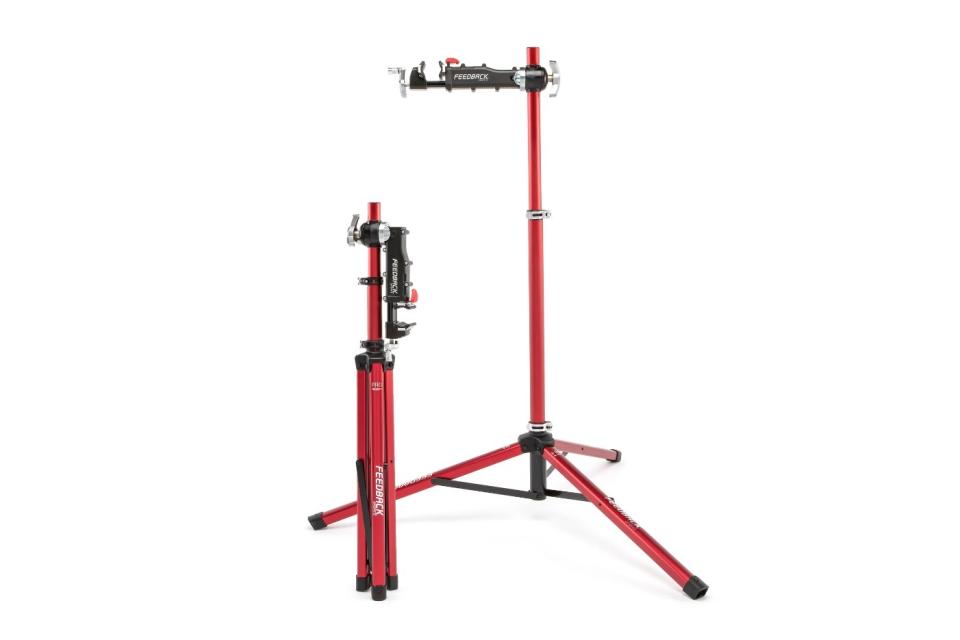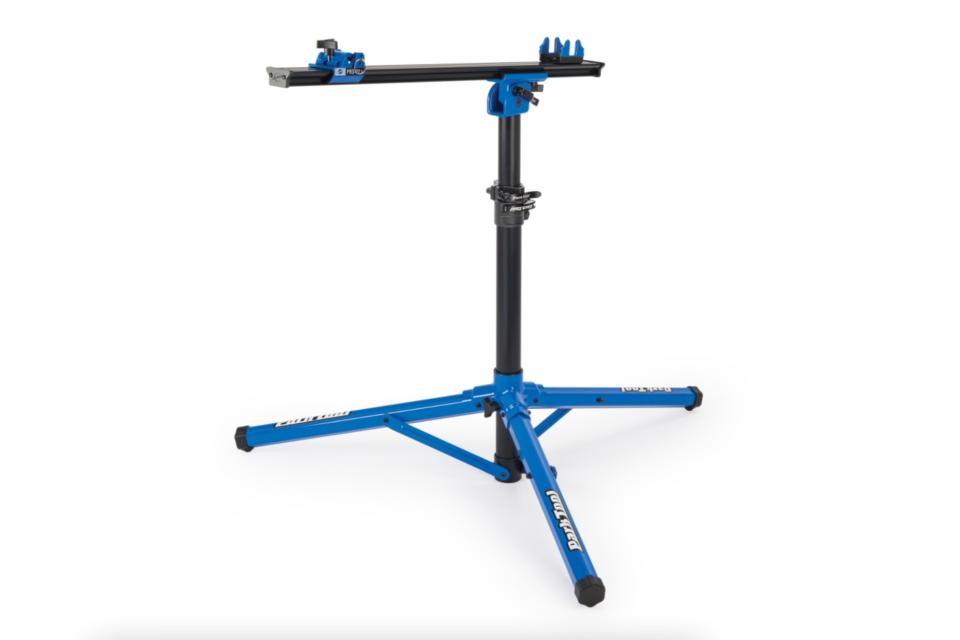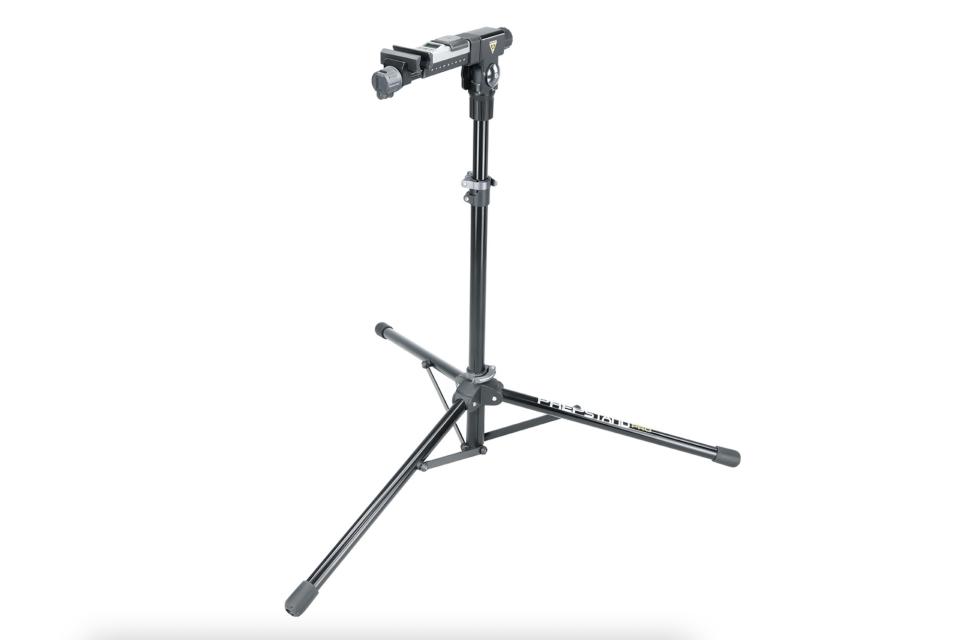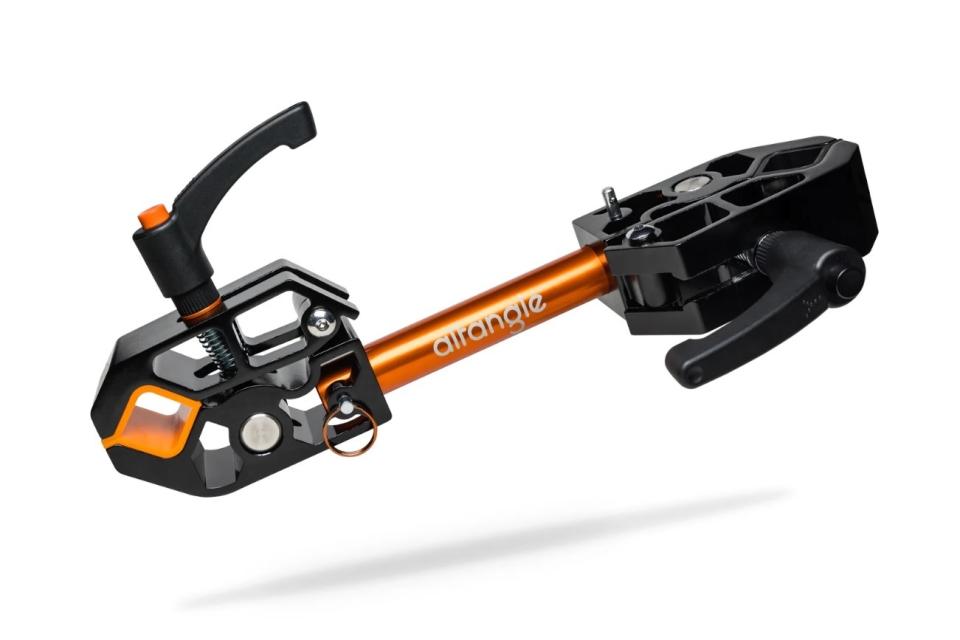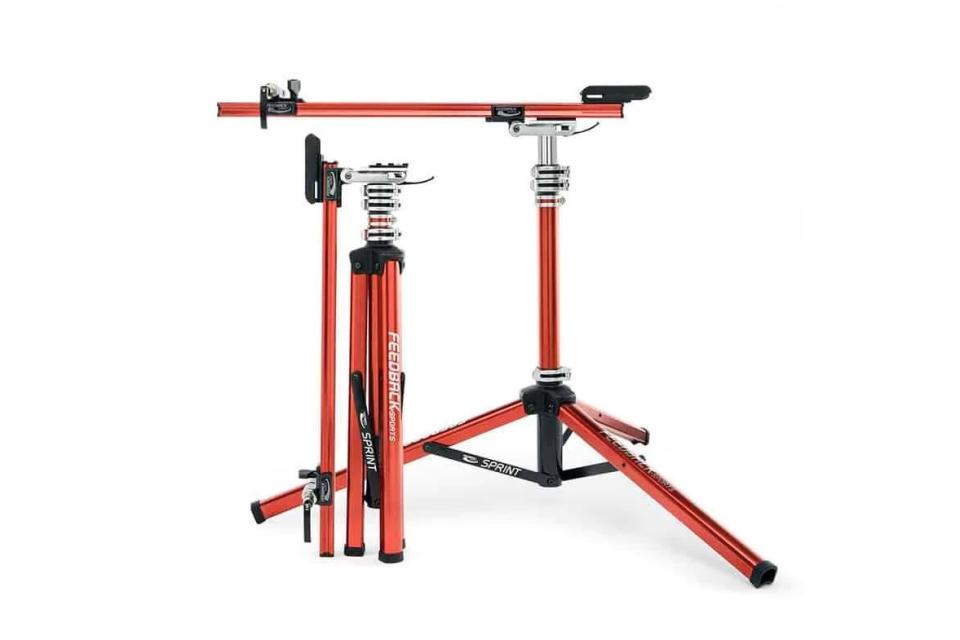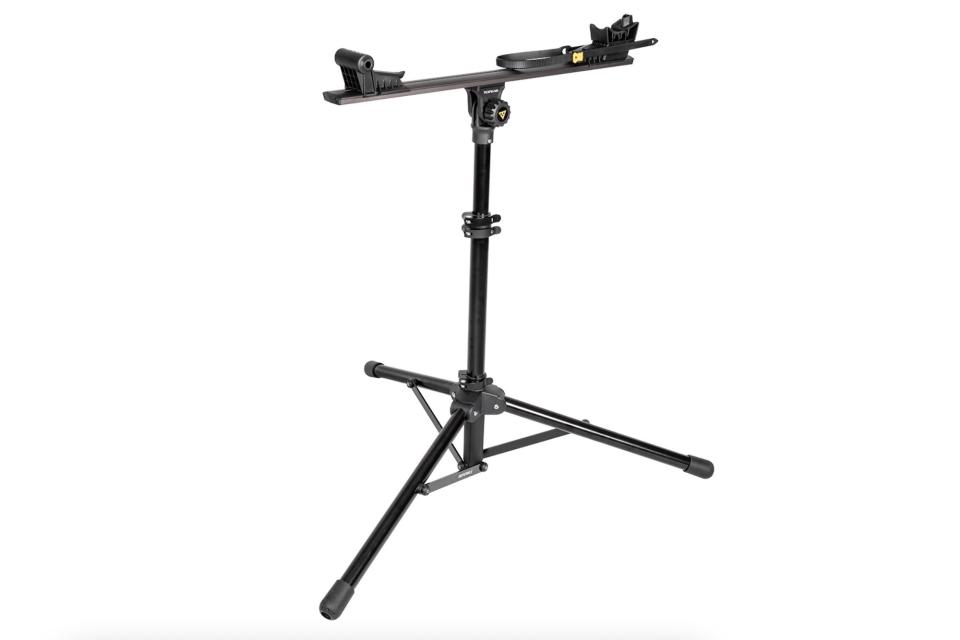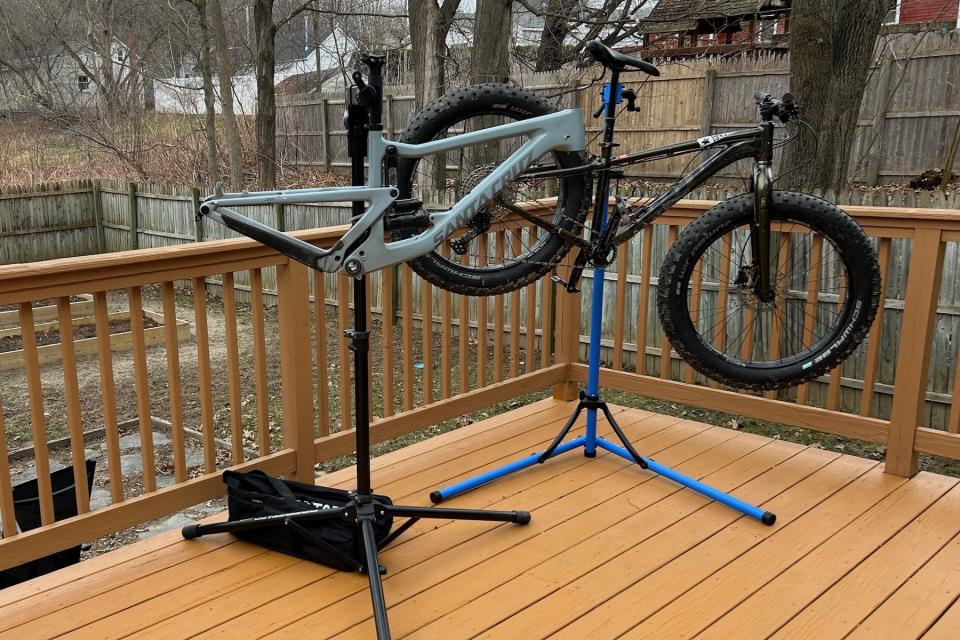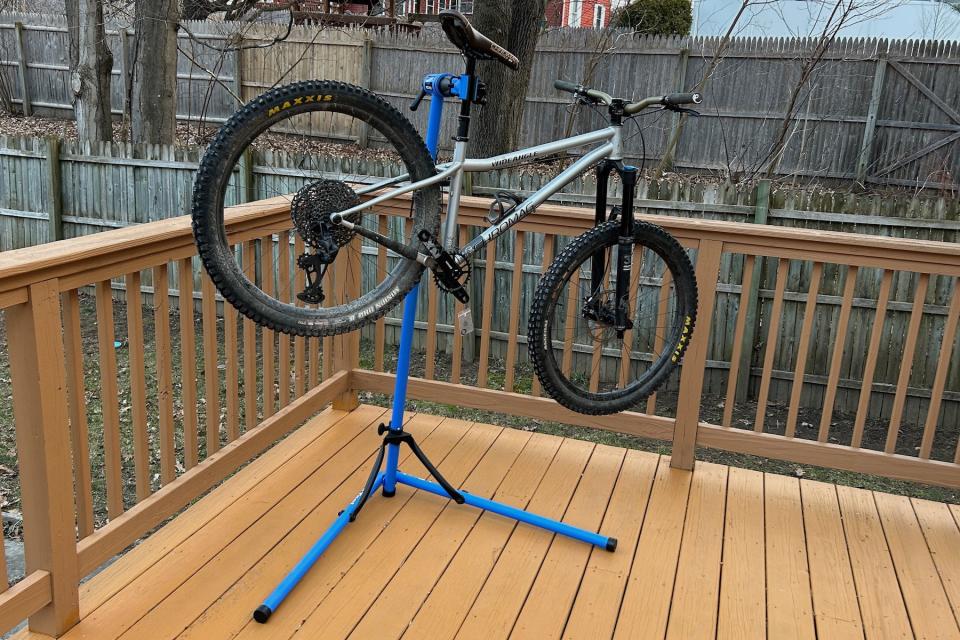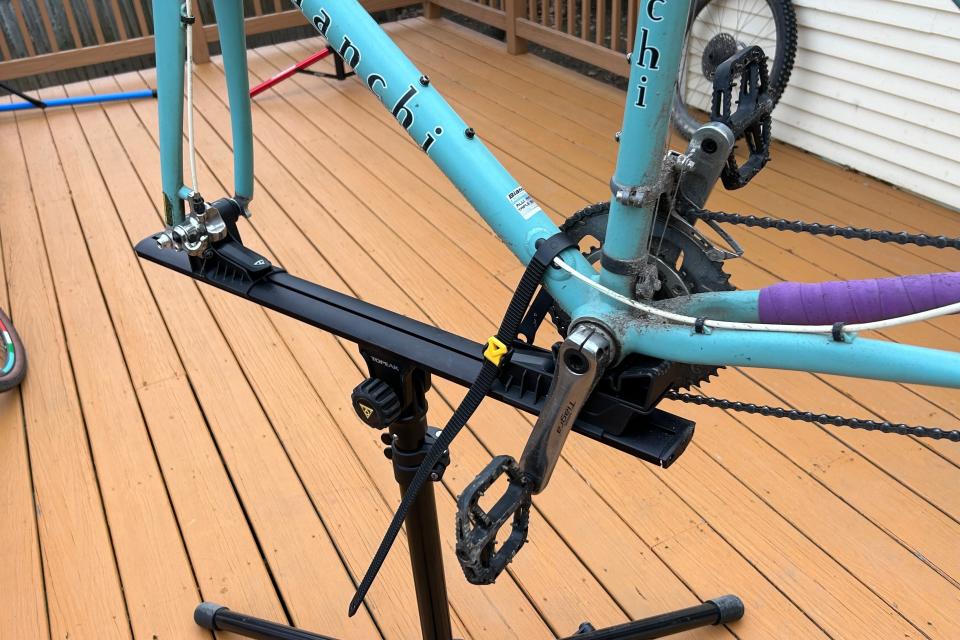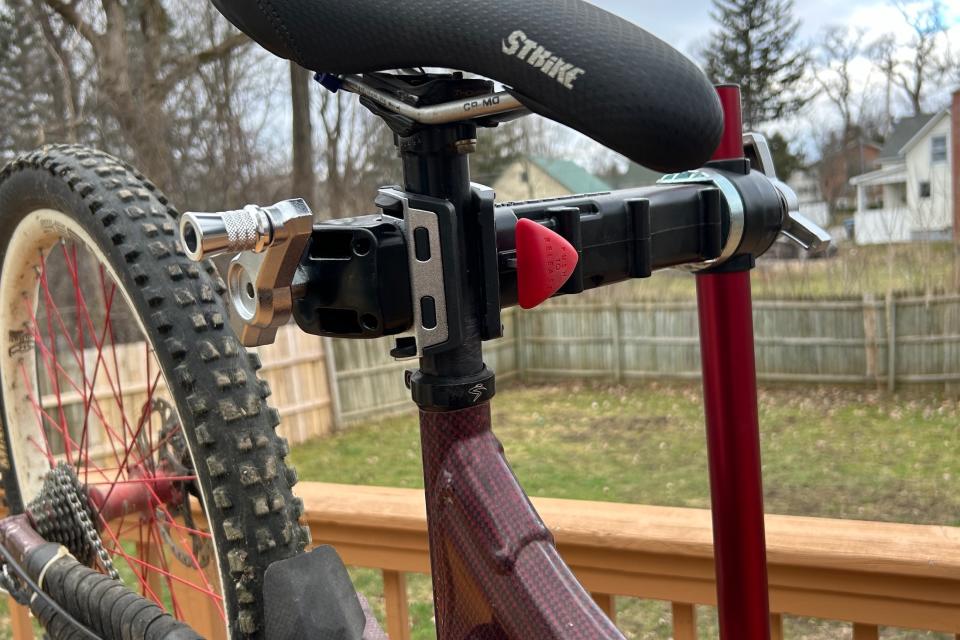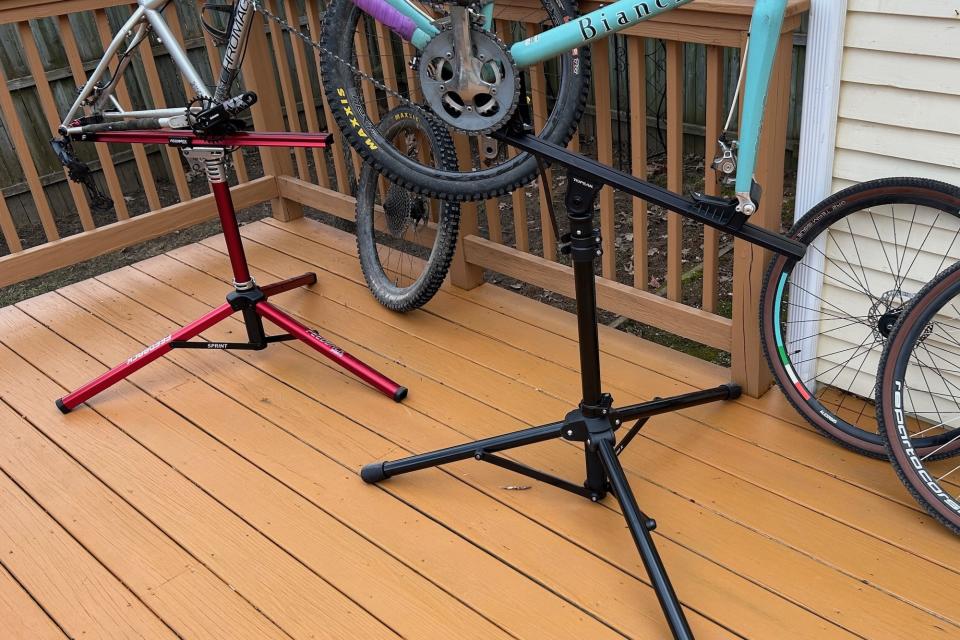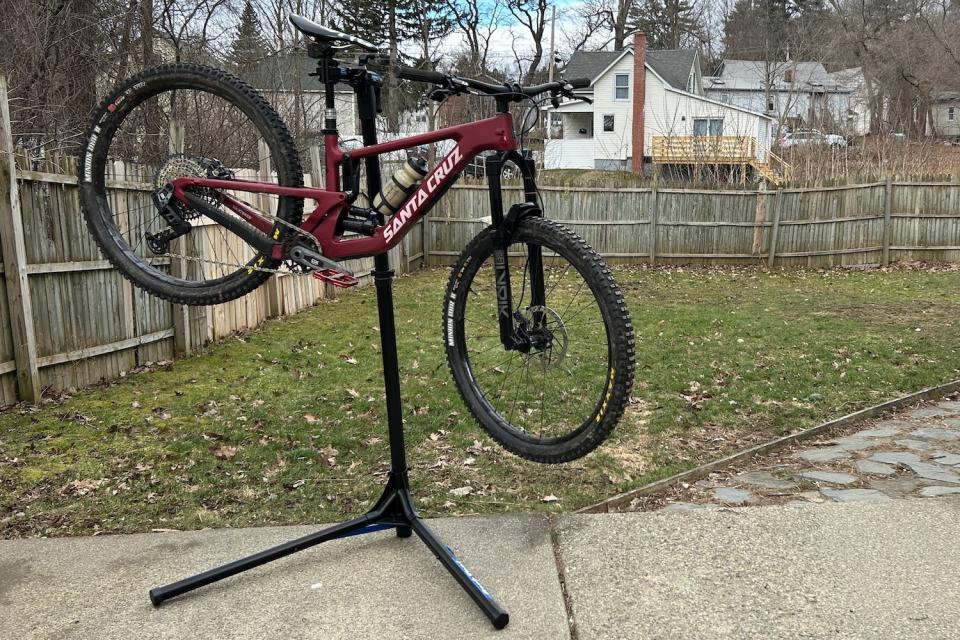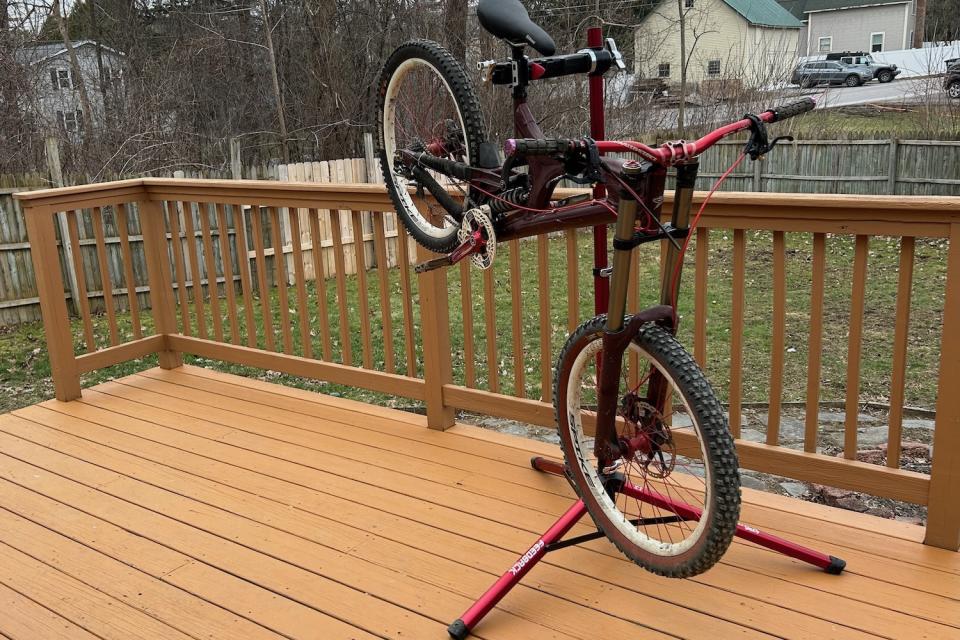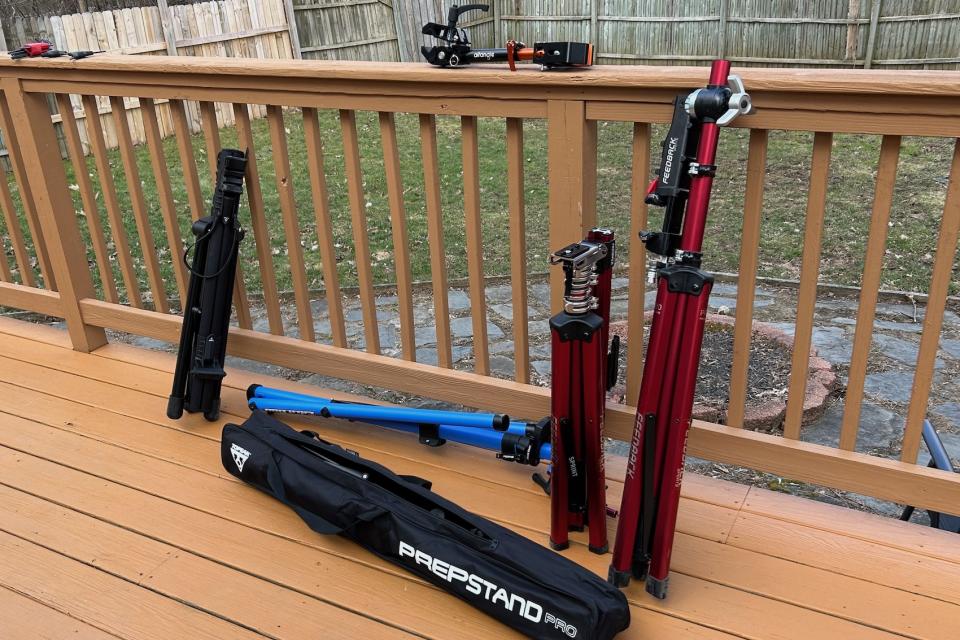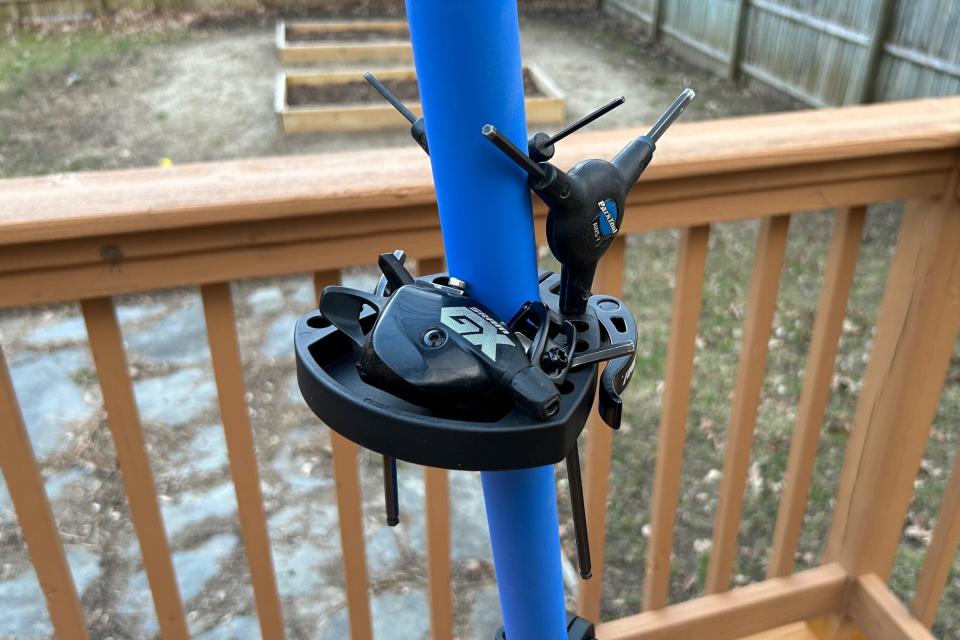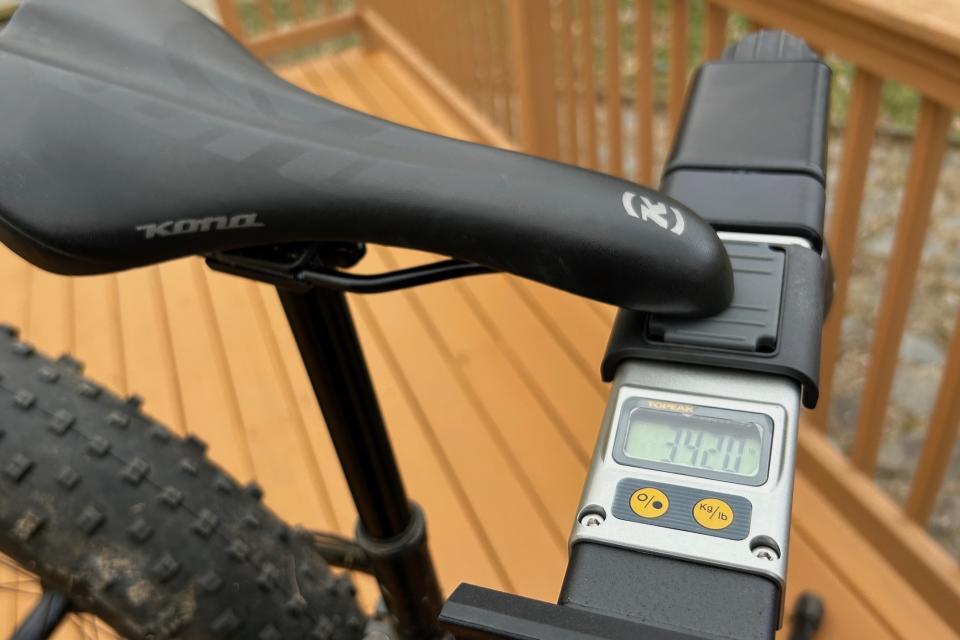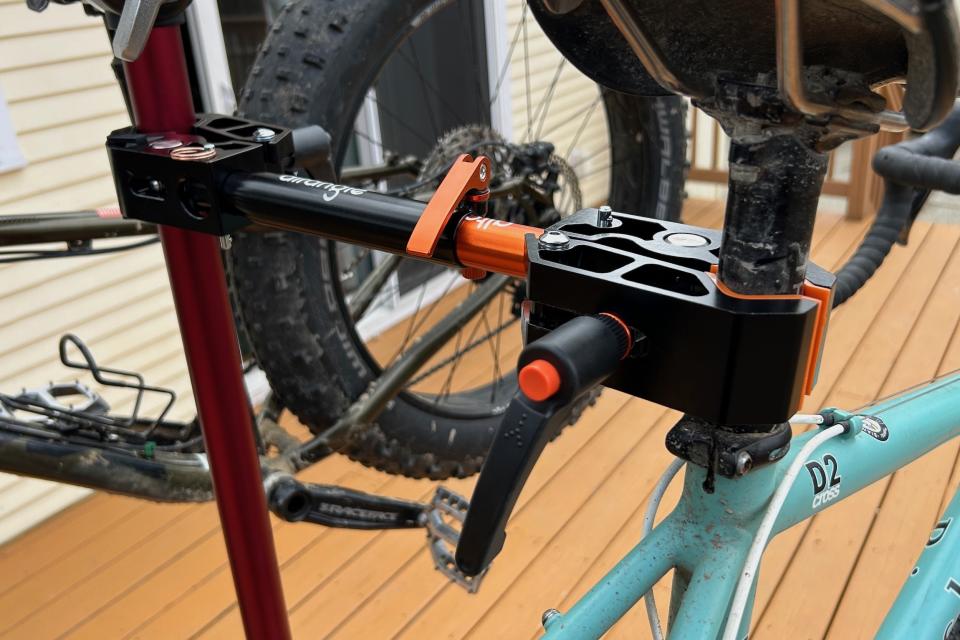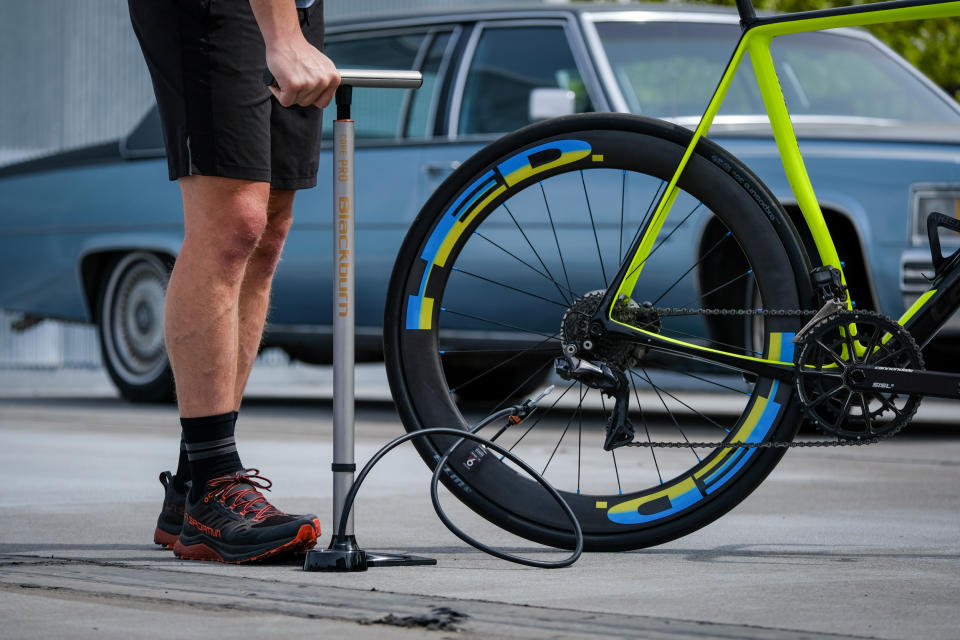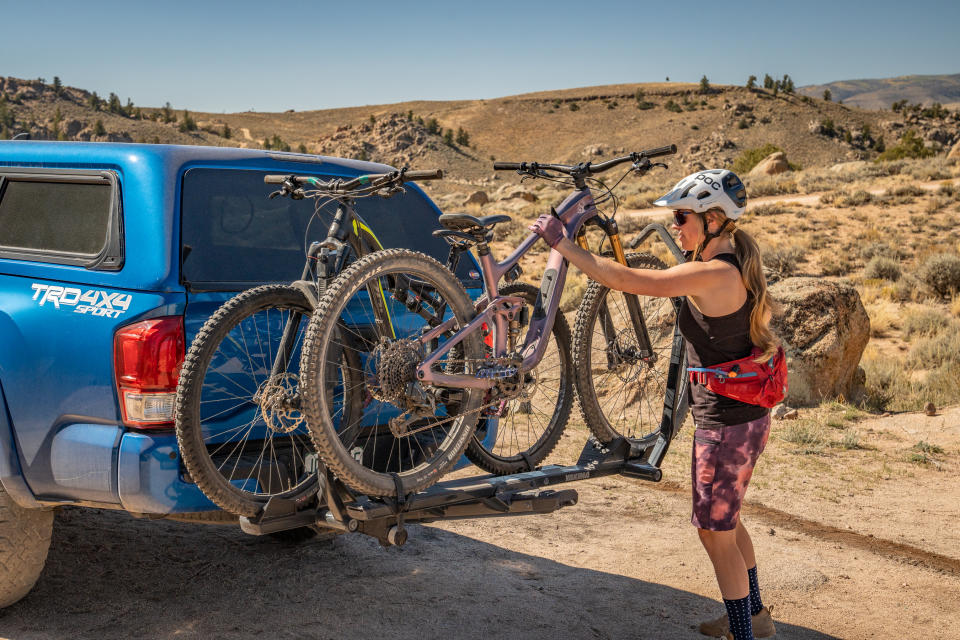The Best Bike Repair Stands of 2024
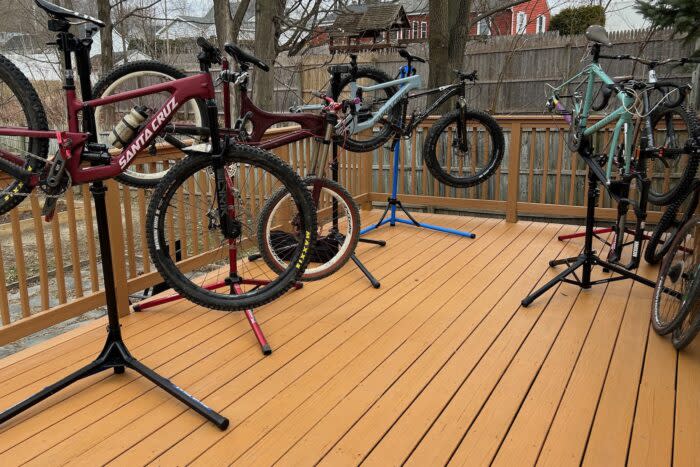
A bike repair stand is a necessity for any cyclist who likes to work on their bikes at home or on the road. Whether you are a casual rider who needs to clean your bike and lube your chain or an experienced mechanic swapping parts and building new bikes, a quality repair stand will make working on any bike quicker and easier.
If you’ve ever worked on your bike without one, then you already know how frustrating it can be. The right bike repair stand can not only save you time and money by avoiding trips to the bike shop but can also dramatically reduce frustration and increase your enjoyment of working on your bikes. But, with so many models to choose from, choosing the right stand for your needs can be a challenge.
To help, our team tested nine of the best tube-clamp and Euro-style portable work stands available today. Our testers are experienced home mechanics who have spent years using bike repair stands for everything from simple maintenance tasks to full bike rebuilds.
They tested each model for months and have recommendations based on stability, clamping mechanisms, ease of use, available adjustments, portability, and value to help every cyclist find the right bike repair stand to suit their needs and meet their budget.
Our top bike repair stand recommendations are listed below. To see the specs of the models we tested at a glance, check out our Comparison Chart. Our detailed Buying Advice covers the important factors to consider when making a purchase decision, and our FAQ section can help answer any further questions you might have while shopping for a bike repair stand.
The Best Bike Repair Stands of 2024
Best Overall Bike Repair Stand: Park Tool Team Issue PRS-25
Best Value Bike Repair Stand: Park Tool Deluxe Home Mechanic PCS-10.3
Best Bike Repair Stand on a Tight Budget: Bike Hand Repair Stand
Best Clamp Design: Feedback Sports Pro Mechanic
Best Euro-Style Bike Repair Stand: Park Tool Team Issue PRS-22.2
Best Bike Repair Stand for the Weight-Conscious: ToPeak Prepstand Pro
Best Bike Repair Stand for Travel: Altangle Hangar Connect
Best Overall Bike Repair Stand
Park Tool Team Issue PRS-25
Specs
Type Tube clamp
Weight Capacity 100 lbs. (45 kg.)
Height Adjustability 47" to 60" (119 cm to 152 cm)
Stand Weight 13 lbs.
Folded Dimensions 46.25" x 8.75" x 8.5"
Pros
Very stable
High weight limit
Easy to set up
Unique tube shape is very sturdy and prevents stand rotation
Cons
Expensive
Clamp head needs to be removed for most compact portable size (not difficult)
Features like a tool tray would be nice for the price
The Park Tool Team Issue PRS-25 ($430) is the brand’s top-of-the-line repair stand made to meet the demands of professionals and discerning home mechanics alike. With a 100-pound weight limit, a super sturdy, stable design, and a quality clamp, the PRS-25 can handle any bike you might happen to own with ease.
The PRS-25 requires no assembly, so if you have an impending project, it is ready to go whenever you are. All that needs to be done is to extend the legs, adjust the height, and thread in the clamp arm. The quick releases are smooth and hold everything in position without needing to be tightened excessively, and the hexagonal “Hexatude” aluminum tubing slides effortlessly when adjusting clamp height while maintaining a high level of rigidity and preventing rotation. The Professional Micro-Adjust clamp can be rotated 360 degrees to any position, is very easy to use, and includes a great set of replaceable, non-marking, rubber jaws.
Like the less expensive Park Tool PCS-10.3, the 36″ x 36″ x 45″ dimensions of the two-legged triangle footing provide an exceptionally stable platform to wrench on no matter the weight of the bike. This stand is ready for some seriously high-torque projects and doesn’t flex at all when wrenching hard on stubborn crank bolts or bottom bracket shells.
At just 13 lbs. and with a folded size of 46.25″ x 8.75″ x 8.5″ — though you need to remove the clamp arm to achieve the smallest collapsed size (it’s very quick and easy, no loose bolts or washers to watch) — the PRS-25 is easily portable for bringing to races, weekend road trips, or storing in your workspace when not in use. There are some additional features that we’d like to see included at the high price point, like an included tool/small parts tray, and a carrying case (both available separately).
Regardless, the Park Tool Team Issue PRS-25 is our top recommendation for mechanics searching for the best portable tube-clamp repair stand with high stability, rigidity, and ease of use. If you’re looking to save a little cash, the Park Tool Deluxe Home Mechanic PCS-10.3 is nearly identical but has a slightly lower weight limit (80 pounds) and heavier weight (16 pounds) for $175 less.
$430 at Backcountry$430 at Amazon
Best Value Bike Repair Stand
Park Tool Deluxe Home Mechanic PCS-10.3
Specs
Type Tube clamp
Weight Capacity 80 lbs. (36 kg.)
Height Adjustability 39" to 57" (99 cm to 145 cm)
Stand Weight 16 lbs.
Folded Dimensions 43" x 14" x 10.25"
Pros
Stable
Tool tray included
Quick, easy setup
Moderate price point
Sturdy and user-friendly clamp design
Cons
Heavier weight
Larger folded size
Rotational clamp adjustment can be sticky
The Park Tool Deluxe Home Mechanic PCS-10.3 ($255) strikes us as the best value of the stands we tested. While there are less expensive options, this all-steel beauty — in classic Park Tool blue — shares roughly the same design and clamp as its more expensive sibling, the Team Issue PRS-25, at a significantly lower price. This stand has an impressive, 80-pound weight limit, excellent stability, and is super easy to use.
Park Tool’s work stands have had the same general design for many years but have undergone incremental improvements to make them more stable and user-friendly. The PCS-10.3 is a good example of this, with teardrop-shaped tubing that prevents rotation under hard wrenching efforts, and the folding leg design that makes it super easy to set up and take down.
The wide footing also makes it super stable, and we had no problems when loosening a SRAM DUB drive side crank bolt that was tightened to 54 Nm. It’s also rated to handle up to a claimed max bike weight of 80 pounds, so there shouldn’t be any bike it can’t handle.
The PCS-10.3 requires some assembly, but only took about 10 minutes to piece together with the included instructions. Using one hand to operate the threaded cam-locking head clamp is extremely easy, as is opening the clamp to release the bike.
The clamp height is adjustable from 39” to 57”, and the 360-degree clamp rotation should allow any home mechanic to position any part of the bike properly for service.
We were also very happy to see an included tray for tools and small parts at this price point, a great example of Park Tool prioritizing function over form when making smart decisions on which features to include for a high-value repair stand.
The PCS-10.3 falls short of some competitors in terms of portability and overall finish. The folded size is slightly larger than most similar tube-clamp stands, and it was the heaviest we tested at 16 pounds (which honestly isn’t that heavy, either).
We also noticed that some of the quick releases, particularly for height adjustment, don’t have a nice place to fold into, and that the clamp arm rotation can be a bit stickier than some competitors. None of this prevented us from using the stand efficiently and effectively, and all represent tiny user-friendliness issues that don’t outweigh the spectacular stability, usability, and durable design of the PCS-10.3.
If you’re looking for the best value, we wholeheartedly recommend the Park Tool Deluxe Home Mechanic PCS-10.3. While it still isn’t exactly cheap, it costs significantly less than the high-end competition while sacrificing very little in terms of performance and functionality.
$255 at Backcountry$255 at Amazon
Best Bike Repair Stand on a Tight Budget
Bike Hand Repair Stand
Specs
Type Tube clamp
Weight capacity 55 lbs. (other versions available)
Height adjustability 39" to 59"
Stand weight 11 lbs.
Folded dimensions 41" x 8" x 8"
Pros
Lightweight
Small collapsed size
Affordable
Heavy duty version available with 110-lb. weight limit
Tool try included
Easy setup
Cons
Not as stable as competition
Lots of plastic parts
If you’re a less frequent repair stand user or simply don’t want to shell out over $200 on a work stand, the Bike Hand ($140) gets the job done and can usually be found on sale for right around $100. While it isn’t quite as fancy or sturdy as some of the more expensive competition, this stand is functionally the same as the other tube-clamp models and you can spend the money you saved on bike parts for those inevitable repairs.
The Bike Hand Repair Stand shares a design similar to the Park Tool models we tested, with two legs that fold down to form a relatively wide footprint. A simple quick-release lever secures the feet in position, while another allows you to adjust the central support anywhere within its 39″ to 59″ height range.
We found that both of these quick releases need to be very tight to keep the feet from folding and the central support from slipping down with a bike in the stand, but they work well when they are adjusted properly.
The clamp arm can be folded down for storage or extended for use, and it also uses a quick-release lever to lock it in place. Compared to our favorite stands, the Bike Hand has a slightly more rudimentary clamp design. It works just fine, mind you; it just doesn’t feel quite as refined or user-friendly. Still, it opens nice and wide and uses a camming lever to tighten down on your seatpost with wide rubber jaws that work with a large range of tube shapes and sizes. The entire clamp head can also be rotated 360 degrees using a toothed ring to lock it in place at your desired angle. While this system works just fine, the wealth of plastic in its construction could be damaged if used carelessly.
In use, we’ve found the Bike Hand Repair stand to be quite stable for cleaning bikes and simpler, low-torque repairs like bleeding brakes and changing cables and housing. The 55-pound weight limit is just fine for most bikes, including lightweight e-MTBs, but we noticed that the stand got less stable when used with bikes around 50 pounds. Stability was also compromised with bikes at weird angles and with the clamp head at its maximum extended height. That said, Bike Hand also makes a heavy-duty version of this stand that is claimed to handle bikes up to 110 pounds. It sells for just $200.
As an added bonus, it comes with a removable tray to hold your tools while you’re wrenching on your bikes. And, with a small collapsed size and light weight of just 11 pounds, this stand is easy to throw in your trunk for a road trip or stash in the corner of your workshop at home.
While the Bike Hand Repair Stand looks and feels a little cheaper than the competition, our test stand has been in use for over 4 years and still works just as well as the day we got it. What it lacks in brand name recognition and refinement, it easily makes up for in functionality and value.
Runner-Up Best Bike Repair Stand
Feedback Sports Pro Mechanic
Specs
Type Tube clamp
Weight Capacity 75 lbs. (34 kg.), "working load": 40 lbs. or less
Height Adjustability 42" to 67" (107 cm to 170 cm)
Stand Weight 12.6 lbs.
Folded Dimensions 45" x 8" x 5"
Pros
Excellent, user-friendly clamp design
Very quick to set up and break down
Excellent finish quality and appearance
Metal quick release collars
Tall max clamp height
Cons
Other options are slightly more stable
Expensive
Additional features like a travel bag or tool tray would be nice for the price
Vertical support can be prone to rotating of not clamped tight enough
The Feedback Sports Pro Mechanic ($395) is, in our opinion, one of the best-looking repair stands available with one of the most user-friendly clamp designs in the business. It is a very well-made stand with durable metal hardware and features that make it stand out from the crowd. But, while the Pro Mechanic is certainly a very functional and striking work stand, a few design choices related to stability kept it from the top of our list in this round of testing.
The primary feature that sets the Feedback Sports Pro Mechanic apart from the competition is the Speed Ratchet + Spinner Knob clamp, which includes a great set of replaceable soft jaws. Operating this clamp is about as easy as it gets. Simply lift the bike and place the seatpost inside the jaws, push the ratcheting clamp jaws closed, and turn the spinner clamp knob about half of a turn.
To release the clamp, simply press the big red clamp release button. The Park Tool Professional Micro-Adjust clamp is almost as user-friendly, Feedback’s design is slightly quicker and seems slightly safer to avoid over-torquing as it does not use a camming lever. And, like the rest of the stand, the clamp just looks great and feels like it should last forever.
The Pro Mechanic has a wide range of height adjustment — 42” to 67” (second tallest in our test) — and the 360° clamp arm rotation is easy to use and stays in place well. The large metal knob at the back of the clamp arm is super easy to grasp and turn when rotational adjustments are needed.
The metal quick-release hardware for the legs and the height adjustment is also fantastic, and all of the parts slide easily and smoothly when setting up and taking down the Pro Mechanic stand. It has a weight limit of 75 pounds and a “working load” limit of 40 pounds, which should work for most people’s needs. If you have heavier e-bikes, however, we’d recommend checking out the beefed-up Pro Mechanic HD ($495) with a 100-pound weight limit.
While the clamp works very well, the stability and rigidity of the Feedback Sports Pro Mechanic fell just a tad below the Park Tool PCS-10.3 and PRS-25, and we experienced a little more flex and rotational twisting while wrenching with this stand. While you can certainly perform any task on the Pro Mechanic, we found ourselves needing to watch it more as the round tubing used for the main pillar of the stand is somewhat prone to twisting, even when the quick-release collar is latched down tight.
When the load rotates, it can compromise the stability of the stand as it moves away from its most stable position, above one of the tripod legs. To be clear, this wouldn’t prevent us from using or recommending this excellent repair stand, but it requires a little bit of attention.
While the Feedback Sports Pro Mechanic isn’t the most stable stand due to the circular tubing, it isn’t that far off either. This work stand has an excellent clamp, a very sleek, refined finish, and it works perfectly for most projects. It also packs down to a reasonable size and is relatively lightweight, making it a good travel option for use before races, road trips, and or demo events. As long as you pay a little attention to the stand’s balance point when you’re working on your bike, this is easily one of the best stands you can buy.
Best Euro-Style Bike Repair Stand
Park Tool Team Issue PRS-22.2
Specs
Type Axle/bottom bracket mount
Weight Capacity 60 lbs. (27 kg.)
Height Adjustability 30" to 45" (76 cm to 114 cm)
Stand Weight 12.5 lbs.
Folded Dimensions 33" x 7.5" x 9"
Pros
No clamping on frame or seatpost tubes
360° rotation makes many tasks easier
Good for working in small spaces
Universal axle carriage, no adapters needed
Easily portable for travel
Cons
Expensive
Needs to be adjusted to work with different bikes
Visiting the pit area of any professional road race, you’re sure to see professional mechanics using what is often called “European-style”, or “cradle-type” repair stands, which look completely different from the work stands found in bike shops.
Euro-style stands, like Park Tool’s magnificent PRS-22.2 Team Issue ($420), are ubiquitous in the race environment because of the aerodynamic shaping applied to the frames and seatposts of modern race bikes, which makes clamping these bikes to tube-clamp style stands risky. Even if your frame has round tubes and a round seatpost, there are plenty of other reasons why the Park PRS-22.2 may work well for you, too.
Rather than grabbing the seatpost, as the more common tube-clamp stands found in bike shops or the portable options in this guide, the PRS22.2 cradles the bottom bracket of the frame, and holds either axle in a clamp or “carriage.” The carriage interfaces with the bike’s existing thru axles, or an included quick-release skewer with spacers that make it adaptable to the spacing of the front or rear hub.
Like many tube clamp stands, the base is a folding tripod, but overall the PRS-22.2 footprint is a bit smaller than most portable tube-clamp stands. The bottom bracket cradle and wheel clamp positioning are adjustable along the length of the stand’s main beam, or tray, so you can set up the balance points to best suit your frame’s dimensions.
While adjusting the PRS-22.2 is fairly straightforward, the lack of a central clamp means that it may also require adjustment as you transition between tasks on the same bike. For instance, to switch from indexing the rear shifting to adjusting the front brake caliper alignment, you’d need to remove the bike and reposition both the cradle and carriage. This is the main reason why this type of stand is not practical for a commercial bike shop, where whole bikes need to be assessed and repaired in the least amount of time possible.
Additionally, the PRS-22.2 will require small adjustments to the bottom bracket cradle positioning or axle clamp positioning anytime you begin work on a different bike, as the wheelbases are most likely not the same. The axle carriage works with any thru-axle size without adapters, but switching between bikes that use a quick-release (9mm) requires removal or reinstallation of the included quick-release skewer and spacers, but is potentially another step in the process of working on various bikes in one session.
Once the bike is mounted to the balance points along the main beam, the bike can spin or “carousel” smoothly in 360 degrees, making the most basic maintenance task — cleaning your bike — a snap, by ensuring quick and unobstructed access to every nook and cranny of the bike from one standing position. It’s also possible to get eyes and tools on whatever you’re working on more quickly, without having to step tediously around the bike.
The height of the main beam of the PRS-22.2 can be adjusted between 30″ and 45″ (76 to 114 cm), and its tilt angle is also adjustable. Again, while it’s not quite as instantaneous as letting gravity adjust the angle of the bike as you would with a tube-clamp stand, this adjustability allows for certain key jobs to be completed comfortably, such as bleeding hydraulic disc brakes.
The Park Tool Team Issue PRS-22.2 is constructed of 6063 T6 lightweight aluminum and high-quality composites, making it Park Tool’s lightest repair stand, but also durable enough to handle life on the road when traveling to races. While it wouldn’t be our first choice for maintaining the family fleet of road, gravel, and mountain bikes on a routine basis, its low weight, small footprint, and durable build make it a great pick for traveling to races with only one bike, or a few similar bikes.
$420 at Backcountry$420 at Amazon
Best Bike Repair Stand for the Weight-Conscious
ToPeak Prepstand Pro
Specs
Type Tube clamp
Weight Capacity 55 lbs. (25 kg.)
Height Adjustability 42" to 70" (107 cm to 178 cm)
Stand Weight 12.7 lbs.
Folded Dimensions 46" x 7" x 7"
Pros
Integrated scale on clamp arm
Included carry bag for easy and tidy transport
Tall max clamp height
Wide tripod base
Cons
Expensive
Clamp design is less user-friendly than others
Sporting a triangular base and round tubing, the Topeak Prepstand Pro ($430) uses a very similar design to the Feedback Sports Pro Mechanic. The addition of a built-in scale on the clamp arm is a unique feature that allows weight-conscious riders to keep tabs on the weight of their bike within ±20 g.
While the Prepstand Pro is a great work stand, there are a few aspects of its design that make it slightly less user-friendly than some of the competition. Still, with a tall clamp height, built-in scale, and travel bag included, it will likely appeal to many users.
The Prepstand Pro has several things going for it. First, the tripod foot design is super stable when the weight is centered over one of the legs. Setting up and taking down the Prepstand is quick and easy with quality quick releases and smooth sliding parts. The clamp arm height adjustment range of 42″ to 70″ is also massive and great for taller mechanics.
It folds down to a nice compact size when not in use, and the included travel bag makes it a super tidy package to travel with. The included travel bag is also something that most other stands charge you extra for. The integrated scale is pretty slick for those who are obsessive about weight, and it’s easy to hang your bike by the nose of your saddle to see if those expensive, weight-saving upgrades are worth it or not.
While perfectly functional, the more basic clamp design isn’t quite as user-friendly as those found on the Park Tool or Feedback Sports models. It requires threading the clamp all the way in and out, as there is no camming lever or quick close feature. We also found the material of the clamp jaws to be a bit harder than most other options.
It was not so hard that we ever worried about scratching in contact with sensitive parts, but it was firm enough that clamped tubes tended to rotate within them more easily than with the Feedback Sports or Park Tool options. And, like the Feedback Sports Pro Mechanic, the round tubing has a tendency to rotate slowly while working on bikes which could result in diminished stability.
Those qualms aside, the ToPeak Prepstand Pro is still an excellent bike repair stand and a particularly attractive option for taller mechanics or riders obsessed with weight. While the clamp isn’t quite as user-friendly as some other options, it still works well and only takes a few extra seconds to load and unload bikes. The included travel bag is also a nice touch that adds a little value compared to other high-end models.
$430 at Backcountry$380 at Amazon
Best Bike Repair Stand for Travel
Altangle Hangar Connect
Specs
Type Tube clamp
Weight Capacity Not specified
Height Adjustability Depends what you clamp onto
Stand Weight 3 lbs.
Folded Dimensions 14" x 6" x 2"
Pros
Very lightweight and portable
Functional repair stand anywhere there's something to clamp it onto
Great as an extra hand in the workshop
Useful for more than just bikes
Cons
Requires something to attach clamp to for use
Works best with lighter bikes
The Altangle Hangar Connect ($265) is incredibly portable and a particularly great option for travel while also being potentially useful for other projects where you might need an extra hand. While it is not freestanding, it weighs only 3 pounds and has tiny 14″ x 6″ x 2″ dimensions that make it super easy to toss in your travel bag, trunk, or camper van to bring along on any adventure. The dual clamp design turns anything you can clamp onto (under about 2.5” in diameter or width) into a bike repair stand.
We tested the Hangar Connect with the optional Pro Bar accessory ($32), which gives continuous 360-degree clamp arm angle adjustability. Without the Pro Bar, the Hangar Connect still offers 360 degrees of head rotation at 90-degree increments through a pin connection. Height adjustment only depends on what you are clamping it to. Altangle also sells the Home Base ($28), which can be mounted to a wall in your garage or workshop to serve as a semi-permanent clamping surface.
We experimented with the Hangar Connect on street signposts, tables, and deck edges, as well as on other repair stands as an extra hand. We appreciated the ratcheting clamp handles for getting very tight connections when attaching the Hangar Connect to these features.
This does come with a word of caution — make sure whatever you attach the Hangar Connect to is very sturdy. We stopped our experimentation when attempting to clamp an old downhill bike from a wooden deck railing, as the bike’s weight and tight, relatively small clamping area could have damaged it. But, when clamping to a street sign or metal handrail, the Hangar Connect provides usable stability for basic maintenance and repairs when it’s cranked down nice and tight.
Given its design, using the Hangar Connect isn’t quite as straightforward as freestanding repair stands, and its overall stability depends entirely on what you can clamp it onto. What the Altangle does very well, obviously, is portability, which will make life easier for riders on the road or flying with bikes who need to do routine maintenance tasks or bike assembly.
For riders with dedicated home workshops, the Hangar Connect provides the added bonus of having an extra hand to hold things while you work. For example, while doing a fork rebuild, we could keep the bike in the main clamp while using the Hanger Connect to hold the fork on the other side of the stand.
The Hangar Connect’s usefulness doesn’t stop there. We could see it being equally handy for tasks around the home, carpentry projects, or camping. So, if you’re looking for the most portable bike repair stand for travel, road-tripping, or to add some convenience to your home workshop, the Altangle Hangar Connect is a unique option that should be on your shortlist.
$265 at Performance Bikecheck price at altangle
Best of the Rest
Another Great Euro-Style Bike Repair Stand
Feedback Sports Sprint
Specs
Type Axle/bottom bracket mount
Weight Capacity 85 lbs. (39 kg.), "working load": 40 lbs. or less
Height Adjustability 30" to 48" (76 cm to 114 cm)
Stand Weight 12.6 lbs.
Folded Dimensions 30" x 7.5" x 5"
Pros
Comes with all the axle adapters you could need
Excellent finish quality and looks
Super stable
Easily portable for travel
Flat BB platform works well with a wide variety of frames
Cons
Expensive
No tray tilt adjustment
No strap for BB included but would be useful
Swapping out and centering adapters can be fiddly
The Feedback Sports Sprint ($420) is a portable Euro-style repair stand that weighs only 12.6 lbs. and folds down to a very small 5” x 7.5” x 30” package, making it highly portable for travel to races and weekend getaways. Like similar stands, it avoids clamping on the frame or tubing and may be the best option for those with super high-end carbon frames or oddly shaped tubing. Feedback Sports smartly includes adaptors for the most common front and rear axle sizes, making it easy to perform any task on nearly any bike, and we loved the classy looks of the red anodized 6061 Aluminum tubing.
The Sprint does not require any assembly, and only two bolts are used for adjustment of the bottom bracket platform when switching between various bikes on the tray. The 30.5” long tray has ample range to adjust between various bike sizes and we feel confident this range should work with virtually any bike. At first, we found it can be a little tricky to center the included axle adaptors in the stand when placing a bike on the tray (particularly when mounting to the rear axle), the learning process never caused any frustration, just a bit of fiddling in the beginning.
The Sprint is very stable, and we never worried about stand tipping while working. This has a lot to do with the weight of the bike being centered above the main post of the stand and tripod base, and the overall weight of the bike is reduced because at least one wheel is removed when mounted in the stand.
While it would be very nice to be able to adjust the tilt angle of the tray — an option on the other two Euro-style stands we tested — the height adjustment (between 30” and 48”) and ability to rotate the bike a full 360 degrees were welcome features that increased the usability of the Sprint. Because the tray angle is not adjustable, front-wheel flop was a common occurrence due to the bike’s position when mounting to the rear axle.
While Euro-style stands will never be as convenient to use as the tube-clamp style, Feedback Sports has done a good job with the Sprint. The included range of axle adapters means that it should be compatible with just about any bike you own, and it’s stable, durable, and packs down into a compact package for easy portability. While it may lack the ability to adjust the tray’s angle, it’s still a very functional, well-made, and great-looking repair stand for those who prefer the Euro style.
ToPeak Prepstand X
Specs
Type Axle/bottom bracket clamp
Weight Capacity 39.7 lbs. (18 kg.)
Height Adjustability 33" to 57" (85 cm to 145 cm)
Stand Weight 11 lbs.
Folded Dimensions 34" x 9.8" x 6.3"
Pros
No clamping on bike tubing
Angle adjustable tray
Integrated ratchet strap for BB area
Adjustable fore-aft and 360° rotation
Les expensive than similar options
Cons
No rear axle mounting options included
Fork mounts require adapters when switching between some bikes
The Topeak Prepstand X ($340) is a compact and lightweight Euro-style bike repair stand that’s a bit more affordable than comparable options. It is very similar to the Feedback Sports Sprint and Park Tool Team Issue PRS-22.2 in that it supports the bike by the bottom bracket and front axle without the need to clamp onto the bike’s tubing. With snap-in fork dropout adaptors, easy-to-use adjustments, and the ability to tilt the tray, the Prepstand X is another good option to consider.
With a 32” long tray, the ability to accept quick-release forks, and adaptors for all standard road, gravel, and mountain bike fork axles, the Prepstand X works with virtually any modern bike. The quick releases to slide both the fork and bottom bracket cradle along the tray make setup when swapping different bikes on and off of the stand quick and easy and the integrated bottom bracket strap holds the bike securely.
Once you’ve got the bike on, rotating the tray with the quick release and tilting the tray with the knob is very easy. The ability to tilt the tray is great for accessing certain parts of the bike and tasks like bleeding brakes and fiddling with cockpit setups. Adjusting the height, using a quick release, is easier without the bike but can also be done without much trouble with the bike mounted.
One knock on the Prepstand X is that it doesn’t provide the option to mount the bike by the rear axle like the other two similar models we tested. While not a deal breaker by any means, it is a little limiting for those times you need to work on the bike’s front end. Still, it’s useful for at least 90% of the tasks you need to use it for, like cleaning and routine maintenance tasks.
The ToPeak Prepstand X is also the least expensive of the Euro-style stands we tested, making it a good value for those who don’t require the ability to mount the bike by the rear axle. It’s stable, easy to use, and packs down small to bring with you for those quick adjustments on race day.
Bike Repair Stand Comparison Chart
Repair Stand Model | MSRP | Type | Weight Capacity | Height Adjustability | Stand Weight | Folded Dimensions |
|---|---|---|---|---|---|---|
$430 | Tube clamp | 100 lbs. | 47″ to 60″ | 13 lbs. | 46.25″ x 8.75″ x 8.5″ | |
$255 | Tube clamp | 80 lbs. | 39″ to 57″ | 16 lbs. | 43″ x 14″ x 10.25″ | |
$140 | Tube clamp | 55 lbs. | 39″ to 59″ | 11 lbs. | 41″ x 8″ x 8″ | |
$395 | Tube clamp | 75 lbs., “working load”: 40 lbs. | 42″ to 67″ | 12.6 lbs. | 45″ x 8″ x “5” | |
$420 | Euro-style | 60 lbs. | 30″ to 45″ | 12.5 lbs. | 33″ x 7.5″ x 9″ | |
$430 | Tube clamp | 55 lbs. | 42″ to 70″ | 12.7 lbs. | 46″ x 7″ x 7″ | |
$265 | Tube clamp | not specified | N/A | 3 lbs. | 14″ x 6″ x 2″ | |
$420 | Euro-style | 85 lbs., “working load”: 40 lbs. | 30″ to 48″ | 12.6 lbs. | 30″ x 7.5″ x 5″ | |
$340 | Euro-style | 39.7 lbs. | 33″ to 57″ | 11 lbs. | 34″ x 9.8″ x 6.3″ |
Why You Should Trust Us
At GearJunkie, we take our recreation seriously, and for the cyclists on our team, that means maintaining and repairing our bikes so they run smoothly and we can perform at our best. For us, that includes having a good bike repair stand, saving time, money, and frustration. And, we want the same for you, so we take our product testing seriously to provide you with honest reviews to help steer you in the right direction when you’re looking for the best repair stand for use at home, on the road, or both.
This bike repair stand buyer’s guide is a collaborative effort combining the expertise of three experienced bike mechanics and product testers. Collectively, our test team has over 60 years of experience using bike repair stands while working on bikes in their home workshops doing routine maintenance, major repairs, and building bikes.
Paul Clauss tested the majority of the models in this review. Paul is a mechanical engineer by trade and has experience working with 3D printing and CNC manufacturing processes for products including bike frames and components. He’s also a skilled bike mechanic who prefers working on his own bikes and loves tinkering with things and scrutinizing the products he tests.
Bennett Shane and Jeremy Benson also contributed to this buyer’s guide. Bennett Shane has over two decades of road cycling and bike mechanic experience. A former racer and obsessive rider, he’s also worked for numerous prominent brands in the cycling industry and has incredible knowledge of all cycling products from the inside out. He also owns and maintains a small fleet of high-end road bikes which he rides while testing a huge variety of cycling gear for Bikerumor and GearJunkie.
Benson is a managing editor at GearJunkie and has been professionally testing and reviewing bikes and related accessories for eight years. He has personally tested and reviewed over ten bike repair stands during that time. While he wouldn’t call himself the best bike mechanic, he enjoys wrenching on his own bikes and the constantly revolving selection of test bikes that end up in his garage.
How We Tested Bike Repair Stands
After rounding up nine of the best bike repair stands on the market, our team tested them for months to determine their strengths, weaknesses, and how they perform in the real world. Our test period happened to be during the depths of winter, giving us the opportunity to use them all extensively for full bike teardowns, major cleaning projects, and complete bike builds. Maintenance and repair tasks these stands were used for include but are not limited to:
Swapping forks, brakes, dropper posts, wheels, and drivetrains between a Chromag hardtail and Santa Cruz Bronson (essentially tearing down and rebuilding two bikes — everything but pressing in headsets)
A full tune of the resulting Chromag hardtail mentioned above.
Completing setup of a new Santa Cruz Hightower (brake bleeds, dropper post installation, cockpit adjustments, GX AXS drivetrain adjustments and installation, frame protection tape installation).
A full tune on a Bianchi cyclocross bike
A full tune, dropper post-installation, and general maintenance on a Kona fat bike through winter use
A RockShox Pike suspension fork rebuild
Assembly and teardown of numerous test mountain bikes
10+ handlebar tape install and removals
Routine maintenance on all of Paul’s, Bennett’s, and Jeremy’s bikes
During testing, we focused on important aspects of each bike repair stand’s performance including setup, adjustments, clamp mechanisms, stability, weight limits, and portability. When testing wrapped up, we compared notes and zeroed in on our favorites and those that excel in specific ways compared to the rest.
Buying Advice: How to Choose a Bike Repair Stand
There’s a lot to consider when choosing a bike repair stand. Here we’ll break down the most important factors to help guide you in making this important purchase decision. And, if you’re in the market for a new bike pump, we’ve tested and reviewed those, too.
Types of Bike Repair Stands
The first consideration when purchasing a bike repair stand is choosing the right type for you and the bikes you’ll be working on. We tested both the more traditional tube-clamp style and Euro-style (axle/bottom bracket mounting) options. Both have their pros and cons.
Tube Clamp
When you go into most bike shops, you’ll see traditional tube-clamping stands. These types of repair stands hold the bike with a set of jaws that clamp around your bike’s tubing, preferably the seatpost. As such, they are impressively versatile in terms of bike fit and will work with most bikes except for some with very oddly shaped tubing (like aero seatposts).
They are quick and easy to use — no need to remove any wheels to throw your bike on the stand to lube the chain or clean it after a ride. They almost always have height adjustability to dial in the clamp height to your needs, and most also feature rotation to adjust the angle of the clamp (and the bike in it) for weight distribution or easier access to certain parts. The options we tested have either tripod-style legs or two legs that fold out from the main support for three points of contact.
Unlike dedicated shop repair stands, the portable models we tested all fold down to a more compact size for storage or travel. That said, they are generally a little bit larger than their Euro-style counterparts. The main reason that some riders avoid tube-clamp repair stands is that they clamp to the bicycle seatpost or frame. Those with potentially fragile frames or oddly shaped tubing may prefer the lack of frame contact provided by the other style.
We tested the best portable tube-clamp options on the market, including the Park Tool PCS-10.3 and PRS-25, the Feedback Sports Pro Mechanic, and the Topeak Prepstand Pro, as well as the super affordable Bike Hand repair stand.
Euro-style: Axle/Bottom Bracket
Euro-style stands do not clamp onto the bike, instead, they support it on a horizontal tray on a bottom bracket cradle and an axle “carriage.” This style of repair stand has traditionally been most popular with road riders and triathletes who have super lightweight frames or oddly shaped aerodynamic tubes that may be susceptible to damage from clamping force or may not fit into tube-clamp stands.
In addition to not clamping the frame, Euro-style stands are quite stable with the bike slightly lower to the ground and the weight centered above the main support and tripod footing. They also allow the bike to be spun 360° like a carousel, making it possible to access different sides of the bike without having to move around it. They also tend to be relatively lightweight and fold down slightly smaller than tube-clamp models for travel.
While we don’t love having to remove a wheel to attach the bike by an axle for every basic maintenance task, Euro-style stands are preferred by many users. The Feedback Sports Sprint, Topeak Prepstand X, and the Park Tool Team Issue PRS-22.2 all fit into this category.
Clamps
Every time a bike repair stand is used, the clamp will be used at least once. It is important that the clamp mechanisms hold tightly enough to keep the bike in position and on the stand, but also not to have a clamp that exerts too much force and risks damaging frames and components.
Tube-clamp stands use a variety of different clamp styles, and higher-end models generally include an upgraded mechanism for ease of use (clamping and releasing). The Park Tool PCS-10.3 and PRS-25 use basic cam levers, which are familiar and extremely easy to use with one hand.
The Feedback Sports Pro Mechanic clamp takes it a step further and its ratcheting jaws can be pushed in easily, tightened quickly, and released with a quick press of a large release button. The Topeak Prepstand Pro uses a plastic knob with a foldable lever to manually tighten and loosen the clamp jaws. While totally functional, it isn’t quite as user-friendly as the aforementioned clamp designs on the Park Tool and Feedback Sports models.
Bikes mount to Euro-style stands by the front or rear axle in a “carriage” and rest on a cradle at the bottom bracket area. Some models also include a strap to hold the bottom bracket down into the cradle for extra security. This requires a wheel to be removed and, in most cases, axle adaptors to be set up when switching between bikes with different axle sizes.
Be sure to check that the adaptors included with a tray stand will work with your bikes. Most modern stands will work with the most common axle sizes on modern road, gravel, and mountain bikes.
Stability
If you’ve ever had to fight to loosen a stubborn crank bolt, remove a seized seatpost, or remove a pair of pedals, you already know how important stability is in a bicycle work stand. Repair stand stability is impacted by many factors including design, foot spacing and shape, height, tube stiffness, and weight of the bike and how it’s positioned. A more stable stand is safer (for you and your bike), and anyone with a heavier e-bike should certainly be looking for a very stable stand with a higher weight limit.
Euro-style style stands are very stable, as they center the bike directly above the main support and footing of the stand, as well as mounting directly to a dropout. Tube-clamp stands are also generally quite stable, but we found the Park Tool PRS-25 and PCS-10.3 to be the most stable due to their shaped tubing (to reduce rotation and flex in the stand) and wide dual-leg footing designs which allow the bike to stay centered over the triangle they form.
The ToPeak Prepstand Pro and Feedback Sports Pro Mechanic are also very stable, but their round tubing allows for a bit of rotation which can move the weight away from the most stable position. If you are paying attention, this isn’t really an issue at all but may require repositioning from time to time.
Adjustments
Bicycle repair stands offer a wide variety of adjustments to position the bike properly for any repair. These adjustments can differ between stands and styles. Adjustments are usually controlled by knobs and/or quick releases, and some (particularly height) should be made before the bike is clamped to the stand.
All of the models we tested for the traditional tube-clamp stands allowed us to adjust the clamp height and rotate the clamp arm 360 degrees, which was plenty to get the bike in a good position for any task we encountered, no matter the stand.
If you are exceptionally tall, the Topeak Prepstand Pro and Feedback Sports Pro Mechanic had the tallest available clamp heights, at 70” and 67”, respectively. Just remember that the higher the clamp arm is positioned, the less stable the stand becomes.
The Euro-style stands we tested differed more in available adjustments. All of them included height, fore-aft position (through the tray itself and the dropout and BB mounts on the tray), and rotational tray adjustments with solid quick-release mechanisms. While the Feedback Sports Sprint was limited to these adjustments, the Topeak Prepstand X and the Park Took PRS-22.2 also allow the tray to be tilted — a welcome feature when bleeding brakes or finalizing cockpit setups on this style of work stand.
Weight Capacity
Weight capacity is an important consideration when choosing the right bike repair stand. Most models can easily handle the weight of most non-electric road, gravel, and mountain bikes (approximately 20 to 40 pounds), and many are rated to hold heavier bikes as well. This is good considering the growing popularity of heavier-weight electric bikes, as we need to be able to work on them, too.
The Euro-style stands range between 40 lbs. (Feedback Sprint and ToPeak Prepstand X) and 60 pounds (Park Tool PRS-22.2). And even though the Park Tool PRS-22.2 could handle some heavier e-bikes, loading them onto a Euro-style stand isn’t ideal. The tube-clamp models all claim to be able to handle a bit more weight with the models we tested ranging between 55 pounds and 100 lbs. Both the ToPeak Prepstand Pro and the Bike Hand Repair Stand are at the lower end of that range, and at 55 lbs., they can realistically handle most bikes other than heavier e-bikes. Keep in mind that maxing out the weight limit of a bike stand will decrease its stability, especially once you start torquing on it.
The two Park Tool tube-clamp models we tested, the Deluxe Home Mechanic PCS-10.3 and the Team Issue PRS-25 are rated to handle bikes up to 80 lbs. and 100 pounds, respectively. That, along with their shaped tubing that prevents them from rotating, makes them both great options for heavier bikes. Additionally, Feedback Sports makes the Pro Mechanic HD ($495) and Bike Hand makes a Heavy Duty version ($200) of their repair stand that are rated for 100 pounds and 110 pounds, respectively.
Portability
The primary factors to consider related to portability are weight and folded dimensions. All of the stands we tested are foldable and portable to some degree. The real standout here is the Altangle Hangar Connect, with a weight of just 3 pounds and dimensions of 14″ x 6″ x 3″. It requires a sturdy object or tube to clamp it onto, but it’s so tiny you can even pack it in your bike travel bag for a flight.
Of the freestanding models, the Euro-style stands make the most compact packages when not in use. They take up very little storage space and easily fit into the trunk of your car to bring with you on the road. While they are a tiny bit bigger, all of the tube-clamp models are relatively compact when folded, too. The Park Tool PCS-10.3 was the heaviest and largest, but even then, at 16 pounds, it’s still easy enough to carry around and throw in the car when needed.
Accessories
Bike repair stands are a home workshop and travel accessory in and of themselves but their functionality can often be improved with accessories. Our favorite repair stand accessory is an attachable tool/small parts tray, which was only included with the budget-friendly Park Tool PCS-10.3 and Bike Hand models.
Most brands offer a range of accessories, including tool trays, though you will typically need to purchase them separately. Trays are a great addition to any bike stand because they allow you to keep small parts (bolts) and tools within reach when at the stand.
To effectively work on your bikes at home, you’ll also need tools. Bike multitools are a good option, but we prefer using separate tools when working on bikes at home. While you can build up a good tool collection over time, it’s often the easiest to purchase a whole set to cover all your bases right off the bat. Park Tool’s Home Mechanic Starter Kit ($200) or Feedback Sports Team Edition Tool Kit ($350) are both great options for home or travel that have most of what you need and will help keep it organized too.
If you will be traveling with your repair stand, a carrying case or bag can be purchased for most of the stands we tested. The only stand we tested that included a bag was the Topeak Prepstand Pro, which was great for throwing it in the back of the car without needing to worry about it being scratched (or scratching other items) or snagging on other gear.
Value
The bike repair stands we tested range in price from around $100 to over $400. Even the least expensive option, the Bike Hand Repair Stand, is perfectly functional and will stand up to years of use if treated with care. As the price goes up, so does the quality of materials, build, finish, and features.
Yes, $400+ is a lot to spend on a bike repair stand, but these things typically have a very long lifespan and will quickly pay for themselves in money saved from doing maintenance and repairs at home. If you’re not willing to pay top dollar, the Park Tool Deluxe Home Mechanic PCS-10.3 ($255) is our recommendation. This stand performs nearly on par with the more expensive models and only suffers slightly in terms of portability with a few pounds of extra weight.
Frequently Asked Questions
Why do I need a bike repair stand?
If you’ve ever worked on your bike while it’s leaned against a wall or flipped upside down, then you know it can be a lesson in frustration. Picking your bike up off the ground and holding it steady with a repair stand makes everything so much easier.
Whether you’re doing routine maintenance tasks like cleaning your bike or lubing your chain or diving into bigger projects like replacing cables, bleeding brakes, or building bikes, a repair stand allows you to adjust your bike’s position to optimize it for the task at hand.
And, while a good repair stand will cost you a bit of money upfront, it will likely save you money in the long run. Having a quality repair stand makes it so much quicker and easier to work on your bike that you’re probably more likely to do it and increase your mechanic skills.
Parts still cost money, but you’ll save on labor costs and definitely save time by avoiding going back and forth to the shop. Depending on the job, you may also avoid having to wait for days or weeks for the shop to fix your bike. More time riding!
All of the work stands we’ve included here are also portable. Not only are they a great addition to your at-home workspace, but they can also be brought along on road trips to keep your bikes running smoothly.
Which is the best bike repair stand?
Honestly, all of these bike repair stands work well and are so much better than not having one at all. The best one for you, however, depends on the bikes you have and your specific needs. Do you most wrench on high-end road bikes?
A Euro-style stand might be the best fit to avoid any clamping of tubes. Of the models we tested, we feel the Park Tool PRS-22.2 is the best, but the Feedback Sports Sprint and ToPeak Prepstand X are both great as well.
For the tube-clamp models, consider your bikes’ weights and choose accordingly. Will you be wrenching on heavy e-bikes? If so, go with a stand with a higher weight limit like the Park Tool PRS-25 or PCS-10.3. Interested in an awesome-looking stand with the most user-friendly clamp design?
The Feedback Sports Pro Mechanic has you covered. Are you flying somewhere with your bike and need something to bring with you, a super portable option for car camping, or an extra hand in the at-home workshop? Check out the Altangle Hangar Connect.
Price is another consideration. In our opinion, the Park Tool Deluxe Home Mechanic has the best price-to-performance ratio. It weighs just three pounds more than the more expensive PRS-25, but it functions nearly identically while costing quite a bit less.
Tube-clamp vs. Euro-style: Which is better?
Choosing between the different styles of repair stands really depends on your specific needs. Generally speaking, we find the tube-clamp style stands to be a bit more versatile and user-friendly. They’ll work with virtually any bike, loading and unloading bikes is super quick and easy, and doesn’t require the removal of a wheel.
That said, they do clamp onto your seatpost or frame (we always recommend the seatpost if possible), so they may not be compatible with oddly shaped tubes or could potentially damage fragile tubing if over-tightened.
Euro stands have their advantages as well. They are super stable, allow the bike to spin 360° for easy access to both sides, and they don’t clamp onto the frame or seatpost. You’ll often see these in the pits of professional road bike races as they are typically preferred by road bike mechanics or those wrenching on high-end, lightweight road and triathlon bikes. If you are scared of clamping onto your super high-end road frame or you have an aero seatpost, this is the way to go.
Where do I clamp on my bike?
We recommend always clamping to the seatpost while using a tube-clamp repair stand. Make sure the seatpost collar is tightened to keep the frame from rotating and so the frame doesn’t slip off.
No frame manufacturers recommend clamping to frames of any material. It is possible to damage a bike frame clamping directly to it, especially if the clamp is over-tightened. As a general rule, try to avoid clamping to your frame.
Clamping to dropper post stanchions is a tricky subject and, to be honest, we usually just watch our clamping torque and do it for quicker repairs or maintenance. We may find ourselves pulling out enough of the dropper post lower to clamp to for longer repairs or if we are really torquing on a crankset, but this is pretty rare.
It is worth noting that most dropper post manufacturers do not recommend doing this, and, if our soft jaws are at all beat up or have sharp edges, we will wrap the dropper post stanchion with a rag before clamping it. If you choose to follow our cavalier approach here, be sure to limit your clamping torque and ensure the jaws are clean/wrap the stanchion in a rag to avoid damaging your seat post.
Euro-style stands make clamping low risk by using the front or rear axle and the bottom bracket resting in a cradle. Again, if you have a super lightweight race bike or oddly shaped tubing, this style of stand takes the stress out of putting it in a repair stand.
What if I have a heavy e-bike?
E-bikes are heavier than human-powered bikes, due to the addition of a large battery, motor, and burlier construction. This means they are harder to lift onto a stand, as well as more difficult to hold in a stand. While the Altangle Hangar Connect might be a good travel option and does not provide a weight limit, we probably wouldn’t recommend it for working on a 50-pound e-bike — particularly because you’d also need to be very careful about what the Altangle was attached to.
The Euro-style stands we tested top out for recommended weight at around 40 lbs, which limits their use with most e-bikes. It’s also worth considering that you’ll need to remove at least one wheel and lift the frame onto the tray, which takes some effort.
The tube-clamping stands had maximum weight ranges of between 55 pounds (the Topeak Prepstand Pro) and 100 pounds (the Park Tool PRS-25), but are designed optimized to work best with likes under approximately 40 pounds. If you expect to be working with heavier e-bikes, very stable options like the Park Tool PCS-10.3 and PRS-25 are a good starting point, and it could be worth looking at non-portable stands like the Park Tool PRS-3.3-2 (or similar), which can be bolted to a heavy, sturdy base.
Which bike repair stand is the most easily portable?
If the ability to travel with your bike stand is of the utmost importance, the Altangle Hangar Connect is by far the most portable option. The only caveat is that it is not freestanding, and it requires a sturdy pole (or similar) to clamp onto for use. Still, at 3 pounds and with small dimensions of 14″ x 6″ x 3″, it can be stashed in your bike bag for a flight and takes up almost no room in your vehicle if you’re on the road.
If you’re not flying, all of the other stands we tested are also relatively portable as they fold down to reasonable sizes that make them pretty easy to stash in your trunk or a roof box for travel on the road. None of them are prohibitively large or heavy. That said, all of the Euro-style stands fold down a little bit smaller and are on the lighter end of the weight spectrum, while the tube-clamp models tend to be a little bit longer overall.
Related Content
The Best Bike Pumps of 2023
Our experts found and tested the best bike pumps of 2023. Whether for road riding, mountain biking, or fat biking, we’ve got you covered.
The Best Hitch Bike Racks of 2024
We reviewed the best hitch bike racks for 2024 with options for every budget. Top picks include Thule, RockyMounts, and more.
The post The Best Bike Repair Stands of 2024 appeared first on GearJunkie.

